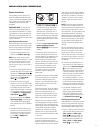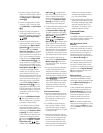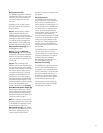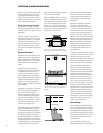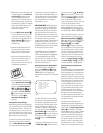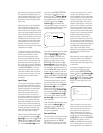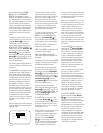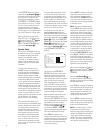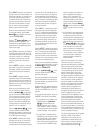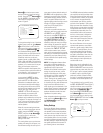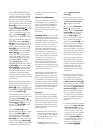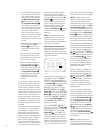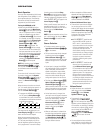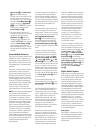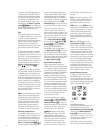
25
When NONE is selected, no signals will
be sent to the center channel output. The
receiver will operate in a “phantom” cen-
ter channel mode and center channel
information will be sent to the left and
right front channel outputs. When only
front left and right speakers are used,
with no center or surround speakers,
VMAx is a good alternative mode.
When you have completed your selection
for the center channel, press the
¤
Button n on the remote to move the
cursor to
SURROUND.
Press the
‹
/
›
Buttons o on the
remote to select the option that best
describes the surround speakers in your
system based on the speaker definitions
shown on this page.
When SMALL is selected, low-frequency
surround channel sounds will be sent to
the subwoofer output only. If you choose
this option and there is no subwoofer
connected, you will not hear any low-
frequency sounds from the surround
channel.
When
LARGE is selected, a full-range
output will be sent to the surround chan-
nel outputs, and NO surround channel
signals will be sent to the subwoofer
output.
When
NONE is selected, surround
sound information will be split between
the front left and front right outputs. For
optimal performance when no surround
speakers are in use, the Dolby 3 Stereo
mode should be used.
When you have completed your selec-
tions for the main surround channels,
press the
¤ Button n on the remote
to move the cursor to
SURR BACK.
This line serves two functions in that it
not only configures the setting for the
surround back channels when they are
present; it also tells the AVR580’s pro-
cessing system to configure the unit for
either 5.1 or 6.1/7.1 operation.
Press the
‹/› Buttons o on the
remote to select the option that best
describes the speakers in use at the left
and right back surround positions based
on the definitions on this page:
When
NONE is selected, the system
will adjust so that only 5.1-channel sur-
round processing/decoding modes are
available and the surround back amplifier
channels will not be used. When this is
the case for your system, you may wish
to take advantage of the availability of
this amplifier channel pair for use in pow-
ering a second set of speakers that have
their source selected by the AVR580’s
multiroom control system. See page 37
for more information.
When
SMALL is selected, the system
will adjust so that the full complement
of 6.1/7.1 surround processing/decoding
modes are available, and low-frequency
information below the crossover point
will be sent to the subwoofer output. If
you choose this option and there is no
subwoofer connected, you will not hear
any low-frequency sounds from the sur-
round back channel.
When
LARGE is selected, the system
will adjust so that the full complement of
6.1/7.1 surround processing/decoding
modes are available, and a full-range
signal will be sent to the surround back
channels, with no low-frequency informa-
tion sent to the subwoofer output.
When you have completed your selection
for the back surround channels, press the
¤
Button n on the remote to move
the cursor to
SUBWOOFER.
Press the
‹
/
›
Buttons o on the
remote to select the option that best
describes your system.
The choices available for the subwoofer
position will depend on the settings for
the other speakers, particularly the front
left/right positions.
If the front left/right speakers are set to
SMALL, the subwoofer will automati-
cally be set to
SUB, which is the “on”
position.
If the front left/right speakers are set to
LARGE, three options are available:
• If no subwoofer is connected to the
AVR580, press the
‹
/
›
Buttons
o on the remote so that
NONE appears in the on-screen
menu. When this option is selected,
all bass information
will be routed to
the front left/right “main” speakers.
• If a subwoofer is connected to the
AVR580, you have the option to have
the front left/right “main” speakers
reproduce bass frequencies at all
times, and have the subwoofer oper-
ate only when the AVR580 is being
used with a digital source that con-
tains a dedicated Low-Frequency
Effects, or LFE, soundtrack. This
allows you to use both your main and
subwoofer speakers to take advan-
tage of the special bass created for
certain movies. Press
‹
/
›
Buttons
o on the remote so that SUB
(LFE)
appears in the on-screen
menu.
• If a subwoofer is connected and you
wish to use it for bass reproduction
in conjunction with the main front
left/right speakers, regardless of the
type of program source or Surround
mode you are listening to, press the
‹
/
›
Buttons o on the remote
so that
SUB LFE+L/R appears
in the on-screen menu. When this
option is selected, a full-range signal
will be sent to the front left/right
“main” speakers, and the subwoofer
will receive the bass frequencies
below the frequency selected, as
described below.
When all initial speaker “size” settings
have been made, you now have the
option to take advantage of the AVR580’s
Triple Crossover system, which allows
individual crossover settings to be made
for each speaker grouping. The low-fre-
quency crossover point is set by the
design of your speakers. Depending on
the design and driver complement of your
speakers, it is defined as the frequency
which is either the lowest possible fre-
quency the speaker is capable of repro-
ducing, or the frequency at which sound
is sent to the speaker’s internal low-
frequency driver, as opposed to the
midrange driver. Before making any
changes to the settings for the crossover
point, we suggest that you find the
crossover point for the speakers in each
of the three groupings, front left/right,
center and surrounds, by looking at the
specifications page of the speakers’
owner’s manual, by getting that informa-
tion from the manufacturer’s Web site, or
by contacting your dealer or the manufac-
turer’s customer service department. You
will need this figure to accurately config-
ure the next group of settings.
The factory default setting for all speaker
positions is 100Hz. If that setting is
acceptable for all channels, then no
adjustments are needed and you may
skip this section. However, should you
wish to change one of the settings,
please proceed by pressing the
⁄
37
37
37
37
37
37



